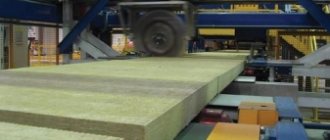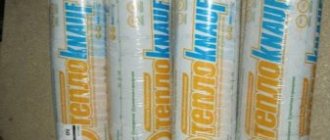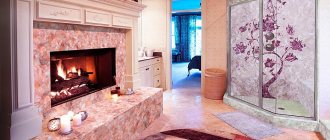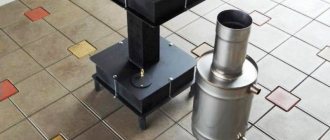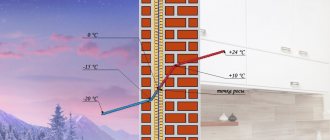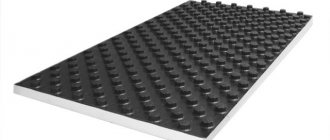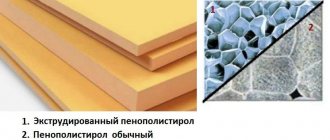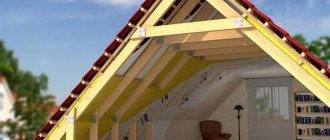Thermal insulation Isoroc is a Russian brand of basalt mats and slabs widely used in construction. Environmentally friendly, efficient and quite affordable materials have already earned a lot of positive reviews and are considered one of the best insulation materials in the budget price segment. But the main thing is that the manufacturer took care of creating a wide range of mini-slabs, so here you can easily find insulation for any job.
Features of mineral wool insulation
Rockwool mineral wool is classified as an environmentally friendly material, for the manufacture of which durable rocks of basalt and gabbro were used without the inclusion of metallurgical waste. The final product has high thermal insulation characteristics and excellent performance properties.
To obtain basalt wool slabs, rocks are melted at elevated temperatures and then drawn into fibers, similar to how the material is formed in natural conditions.
Unlike mineral wool-based insulation of the previous generation, when the fibers were laid in strict order in rows, Rockwool basalt wool slabs are created with fibers laid in a chaotic manner, which favorably reflects the technical characteristics of the material, reducing its specific gravity.
Analysis of the characteristics of the insulation allows us to note its ability to cope with high temperatures - Rockwool slabs can withstand temperatures over 1000 degrees Celsius. Insulation is used both in domestic construction and for thermal insulation of industrial facilities, where compliance of the characteristics with fire safety requirements is fundamentally important.
Materials based on Rockwool mineral wool are universal and practical, helping to create and maintain a comfortable microclimate in the room, regardless of the time of year.
Material characteristics
Many types of material have been created for the range of Izorok brand insulation, but all have certain characteristic features.
- Low thermal conductivity. Due to the presence of a large number of air pores in mineral slabs, it is possible to accumulate and retain heat in the wall of a building, which helps reduce energy costs.
- High level sound insulation. Mineral wool insulation has a special structure, which consists of small fibers, and they have excellent sound insulating properties. The fibers differ from each other in length, which effectively absorbs the energy of any waves (sound). When using mineral slabs, you can perfectly solve the problem of sound insulation of a room.
High tensile strength. Thanks to the high level of resistance of the slabs to mechanical stress, it is possible to improve the properties characteristic of insulation - heat insulation and sound insulation.- Resistance to deformation. Reviews about Isorok are such that the insulation materials of this brand have excellent strength properties, which help ensure the durability and strength of the material.
- Water-repellent properties. This characteristic was made possible due to the fact that the material contains special hydrophobic additives that help prevent moisture from penetrating into the material, which in turn also increases the thermal insulation properties of mineral slabs.
- Fireproof qualities. The material contains natural non-flammable elements that help the fibers maintain their original properties at a wide range of temperatures.
- Environmental friendliness. All products from the Isorok brand are made only from natural and pure raw materials, which helps ensure high performance of the finished material. The use of insulation based on mineral wool of this brand will be your guarantee of providing ideal living conditions in any room that you insulate with these slabs.
- High resistance of all insulation products in the line to the destructive influence of negative environments.
- Water resistance. Mineral insulation is so good that insulation can be carried out using aqueous solutions.
- The material is high-strength, and part of the strength is achieved during the production process, and this helps to create buildings that will not shrink, which means there will be no deformation of the insulation sheets and the quality of the work performed will be high.
- Resistance to microorganisms and fungi, since the nature of the material used is inorganic.
All varieties of Isorok are durable and retain their performance characteristics well even after the warranty period expires, which has become the best recommendation for both large developers and individuals who have set themselves the goal of reliability and high-quality insulation of their homes.
Product line
The density of Isoflor allows it to be laid under a concrete screed or decorative floor.
The Isoroc line of wall insulation contains several subtypes, focused on the characteristics of the surfaces being protected and various areas of application. It includes the following items:
- Izolight-L;
- Isovent;
- Isofrol;
- Izoruf in packs;
- Isorok in slabs (in cylindrical shapes).
Samples of Izolight-Lux products have a density of 60 kg/cubic meter. meter and are used to insulate surfaces of various orientations. At the same time, large loads and deformation stresses in the layers of products of this type are unacceptable. The next model in the series, Isovent-L, has a significantly higher density (up to 90 kg/cubic meter) and is used for arranging ventilation for building facades.
For the Isoflor modification, the density indicated by the manufacturer is close to 140 kg/cubic meter. m. This insulation is used as an intermediate link in three-layer reinforced concrete structures. Can be used in sandwich panels. For thermal insulation of roofs and concrete floors, another type of insulation material called Izoruf is used. It is produced with the markings H, B or NL, and its average density is 110 kg/cubic meter. meter. Blanks of this material or mats without a piercing shell are marked as “MP”, and if it is present – “MP (ST)”.
Isorok insulation in slabs has two modifications with a material density of 75 and 100 kg/cubic. per meter respectively. They are optimally suited for protecting any horizontal surfaces, but do not allow the load to exceed the maximum level. Isorok Cylinders, marked CF, are considered as a separate category of heat insulators. Various samples of these products differ in the diameter of the cylindrical blanks (ranging from 18-273 mm) and are used for insulating cold water and hot water pipes.
Description of types and characteristics of Isoroc wool
1. Lightweight Izolight series.
The manufacturer recommends using such slabs for insulating all main elements of residential buildings. However, do not forget that due to their low weight they do not have sufficient rigidity, therefore, on vertical and steeply inclined surfaces, soft mats will inevitably slide during operation. Yes, any insulation made from low-density Isorok mineral wool is effective, but over time this advantage will be practically reduced to zero due to gaps that appear in the general layer of thermal insulation.
Light basalt mats Izolight are divided into separate categories by weight:
- Isorok Ultralight is a relatively new thermal insulation in this line with a minimum density (only 33 kg/m3). Available in two sizes: 50 and 100 mm.
- Izolight and Izolight-L (50 and 40 kg/m3, respectively) can well be called universal insulation materials, since their rigidity is sufficient for most basic operations: from insulating floors and roofs to creating an inner layer under dense slabs in ventilation facade systems.
- Isolite-Lux is a fairly dense Izorok insulation material, which is really suitable for steep roof slopes and interior partitions. Its weight reaches 60 kg/m3, while the thermal conductivity is one of the lowest in this group - from 0.033 to 0.04 W/m·K, and the compressibility does not exceed 7%.
2. Isoroc for facade work.
Here, thermal insulation is traditionally divided into slabs for ventilated facades and external walls for plaster. Both types are distinguished by very low water absorption - only 0.5%, but this is achieved by increasing the content of organic resins connecting the Isorok basalt wool fibers. However, when used outside residential premises, this no longer matters.
Isovent - comes in two density options: 90 and 80 kg/m3 (modification L). The difference seems small, but in fact the technical characteristics of Isorok products change noticeably from this. Although the thermal conductivity remains approximately at the same level, the compressive strength doubles with increasing specific gravity - from 10 to 20 kPa. With such indicators and sufficient density, Isovent can be used even in three-layer brick structures. The dimensions of the insulation are somewhat non-standard - 500x1000 mm, the thickness, depending on the modification, is selected from the range 40(50)-160 mm.
For plaster, you can buy Isofas mini-slabs with a density of 90-160 kg/m3 (4 varieties in total). Heavier basalt wool allows finishing work even without mesh reinforcement, since its tear strength of layers is three times higher than for 90/110 slabs (15 kPa versus 5). Isophas insulation can withstand compression from 15 to 55 kPa.
3. Isoroc for flat roofs.
This type of thermal insulation is more in demand in industrial and multi-story construction, since the Izoruf series was developed directly for flat roofs. Depending on the installation method and position of the mini-slabs, choose one of the following types:
At a density of 150 kg/m3 it shows a strength of 50 kPa and an efficiency of 0.036-0.044 Wm·K. This thermal insulation is suitable for subsequent installation of roll roofing and does not require additional reinforcement with cement screed.
The bottom, also known as the inner layer of double thermal insulation of flat roofs. It has a lighter weight (130 kg/m3) and minimal thermal conductivity, thereby providing the necessary protection for the structure. Isorok can withstand compression up to 35 kPa, but if such indicators seem too high, you can use an analogue from the NL series of insulation materials - here the density is only 115 kg/m3, and the strength reaches 30 kPa.
This is already the top layer, which requires high strength (65 kPa for compression and 15 for detachment), since it bears the main load of the roofing covering. The density of rigid slabs is 175 kg/m3, but the choice of sizes is small: only Isoroc with a thickness of 50 mm or an even rarer option - 40 mm, which can be purchased to order. However, the main function of this insulation is to support the weight of the roof covering and prevent deformation of the lower substrate under point loads.
4. Izorok for floors and ceilings.
Isoflor is used for all types of floors that are under load, including as insulation for concrete floors. Although the density of these slabs is only 110 kg/m3, which casts doubt on their ability to withstand the weight of the screed. Compressive strength is 25 kPa, water absorption is also not the lowest - 1%. But the thermal insulation characteristics are really good - 0.034-0.042 W/m K.
5. Special types.
The Isorok company produces tufted mats of the MP and MS series, quilted with steel wire, glass roving or reinforced with metal mesh. The operating temperature range for these insulation materials is quite wide (-180..+700 °C), since there are no resins that bind the fibers, which in other types of insulation limit its scope to +400 °C.
- protection of production equipment;
- insulation of pipelines and chimneys;
- installation of fire-prevention cut-offs.
If the heating temperature of the pipes does not exceed +400 °C, the technical thermal insulation Izorok in the form of shells 1 m in size made of basalt fiber will cope with the task. These are hollow cylinders with water-repellent impregnation Ishell-Ts, as well as products of the TsF brand, laminated with aluminum foil. Both types of insulation are available for 22 different pipe diameters (from 18 to 273 mm) with a wall thickness of 3-9 cm.
Information about the manufacturer Isorok
Izorok products are manufactured in compliance with European standards.
The date of appearance of the Russian brand “Izorok” is considered to be 2000, when a large association was created on the basis of the Tambov Mineral Insulation Plant. The further development of this production was supported by investments coming from a number of foreign companies.
Over time, Isorok mineral wool has become a very popular product, in demand in most areas of construction technology.
To expand the volume of mineral wool production, the association needed:
- significantly expand its production areas;
- acquire modern equipment that allows you to automate the work process;
- master new technologies for waste-free production of insulation products.
Thermal insulation Isorok is made on the basis of the finest fibers from a melt of mineral rocks, the individual components of which are held together by a special binder. The need to comply with all the subtleties of the technological chain stimulated the concern's engineers to constantly improve this process. Today it belongs to the undisputed leaders of the Russian market of insulation materials.
Mineral wool Isorok characteristics and advantages of use
Developed on the basis of the latest global innovative achievements, the insulation is several times superior to similar materials.
Isoroc thermal insulation has the following advantages:
- low thermal conductivity;
- high fire resistance;
- resistance to chemical compounds;
- strength during deformation and peeling of layers;
- soundproofing ability;
- vapor permeability, etc.
Isorok thermal insulation is used quite widely in civil and industrial construction. It is in demand where it is necessary to ensure fire safety, create sound insulation, and reduce the load on the foundation.
An environmentally friendly material, developed on the basis of natural materials, makes it possible to create favorable conditions indoors.
Description
Minvata Isorok Izolight P-50
- Minvata Isorok Izolight P-50
- Width of Izolight-50 slab - 500 (standard) and 600 mm
- The length of the insulation board is 1000 mm
- The thickness of the ISOLIGHT thermal insulation board is 50 mm
- Number of slabs per package - 8 pieces
- Packaging volume Izolight (50) - 0.20 m3
This is a super insulation material, widely used in construction and repair work. It is created based on natural materials. Mineral wool itself has a porous surface. The presence of a large number of pores provides sound insulation and a low level of thermal conductivity. The material does not absorb moisture, providing excellent ventilation. In addition, Mineral wool Isorok Izolight P-50 belongs to the non-flammable group, that is, fireproof. The insulation is tensile strength and slightly susceptible to deformation. With its help, you can significantly improve the noise insulation characteristics of a room. The insulation can be used both in private civil and professional construction, and in commercial facilities when installing roofs, floors, thermal insulation of walls, facades, and ventilation systems. From the foundation itself to the roof, including facades, interfloor ceilings, wall partitions and any other, even narrowly targeted places - all this is more than completely thermally insulated by materials.
Properties of mineral wool sandwich panels
Sandwich panels made of mineral wool are quite popular in construction. The thermal conductivity coefficient of this material is equal to the limit from 0.20 to 0.82 W/m*K. The degree of sound insulation of the material is 24 dB. The shear strength is 100 kPa, as is the compressive strength. The density of products can be equal to the limit from 105 to 125 kg/m3.
The structures do not require the use of special equipment for construction work; they are easily exposed to ultraviolet radiation and temperature changes. Sandwich panels do not rust, they are fire resistant and have excellent heat and sound insulation properties. If the panels are damaged, partial replacement is acceptable. Such structures do not create unnecessary load on the foundation. By visiting the store, you can choose any shade of the panels, which allows you to achieve an excellent aesthetic result.
Thermal conductivity coefficient of Ursa wool
The table of thermal conductivity and other qualities of the material quite often allows consumers to make the right choice. This is also true when it comes to Ursa mineral wool. If you need insulation for thermal insulation of the roof, floor and walls, then you can choose Ursa Geo M-11 with a thermal conductivity coefficient within 0.040 W/m*K. The slabs, presented in rolls and produced under the name URSA GEO, are intended for pitched roofs. The thermal conductivity coefficient in this case is 0.035 W/m*K.
To insulate floors, acoustic ceilings and ceilings, URSA GEO Light rolls are used, whose described characteristic is equal to the limit of 0.044 W/m*K. As practice shows, the properties of mineral wool insulation under the Ursa brand are among the best. Using this insulation, you can reliably insulate a house, resulting in the formation of a breathable surface with air layers. Using a unique recipe and environmentally friendly technology, Ursa Geo is produced, which deserves special attention.
Reviews
Tanya n, Lipetsk
To insulate the floor of the attic of a country house, Izorok slabs 1 x 0.6 m and 5 cm thick were taken. They were laid in two layers with a shift (to close the seams). For a floor area of 125 m2, 47 packages of 8 sheets were purchased.
During the preparation process, the slabs were cut using a paper knife. Cotton wool is very scratchy, so cutting and laying was carried out in respirators, rubber boots and gloves. A vapor barrier was installed on both sides of the insulation layer (material from the same manufacturer was used). This is done to minimize the likelihood of moisture getting into the mineral wool. Based on the results, I can note good sound insulation. Now we wait for winter to determine thermal efficiency.
iliya2002, Orel
I bought Izorok to insulate the walls and floor of the balcony. I chose it as the most inexpensive (360 rubles per package per 4 m2). I immediately noticed the light weight and the lady carried the purchase herself. The material is soft to the touch and easily deformed. I think to use wind and vapor protection for reliable thermal insulation.
Vladimir 68, Tambov
In my line of work, I often come across the insulation of premises. Many clients believe that the more expensive the better. But among budget products it is worth noting Isorok mineral wool. It is presented in a wide range, so everyone can easily choose the desired option. Mineral wool is easy to work with, it practically does not prick.
klim1983, Voronezh
I had long heard about Izorok insulation, and when it came time to insulate the facade, I chose it. It does not rot, is not flammable, and is not eaten by rodents (which is especially important for private buildings). The material provides good sound insulation and is suitable for facades, roofing systems, partitions and ceilings. And what’s even nicer is that all this is at a low cost.
I purchased standard sheets 100*50*5 cm. I laid them in two layers to cover the cold bridges. On top is siding. I would like to point out right away that in order to obtain decent insulation, it is important to follow the basic rules - to organize high-quality vapor barrier and wind protection.
I got a decent result. The house became much warmer in cold weather with lower heating costs, and cooler in hot weather.
Universal thermal insulation ISOLIGHT
The Izolight series is a slab made of moisture-resistant basalt wool. Available in 3 types, differing in density. Used in residential, non-residential and industrial structures as unloaded heat and sound insulation. Scope of application – universal (external and internal walls, partitions, roofing, ceilings, basements), for any type of surface and slope.
Technical characteristics of Isorok Isolite:
| Indicators | Izolight-L | Isolite | Izolight-Lux |
| Density, kg/m3 | 40 | 50 | 60 |
| Length, cm | 100 | 100 | 100 |
| Width, cm | 50 | 50 | 50 |
| Thickness, cm | 5-20 | 5-20 | 5-20 |
| Thermal conductivity t=+10 °C, W/mK | 0,036 | 0,034 | 0,034 |
| Thermal conductivity t=+25 °C, W/mK | 0,038 | 0,036 | 0,038 |
| Water absorption by volume, % up to | 1,5 | 1 | 1,5 |
| Humidity by mass, % up to | 0,5 | 0,5 | 0,5 |
| Content of organic substances, by weight, % up to | 2,5 | 2,5 | 2,5 |
| Compressibility, % up to | 30 | 15 | 7 |
Reviews about Isorok insulation of the ISOLIGHT series are mostly positive, although there are some complaints:
“Thermal insulation of walls Isorok Isolite does not require special skills, although it must be handled with care. According to subjective feelings - very warm material
However, in the hands it partially delaminates; the flaps can be torn off with a little tension. For the same reason, it is necessary to cut to size with a very sharp knife or a saw with fine hardened teeth, otherwise the cut will be uneven, with tears.”
Pivovarov Mikhail, Moscow.
“I really liked ISOROC, warm, dense insulation, well packaged. On the day of purchase, it was raining, we were transported in an open car, but not a single drop leaked inside. At the same time, it cuts, crumples and installs easily.”
Golubev Boris, Samara.
Universal insulation ISOVENT
The Isorok Isovent complex is non-flammable slabs made of moisture-resistant mineral wool. Available in 2 types, they are used for thermal and sound insulation of enclosing devices of all types (horizontal, vertical, inclined), and curtain facades. A special condition is the presence of an air gap between the finishing coating (ventilated facades, siding) and the base.
Technical characteristics of ISOVENT:
| Indicators | Isovent-L | Isovent |
| Density, kg/m3 | 80 | 90 |
| Length, cm | 100 | 100 |
| Width, cm | 50 | 50 |
| Thickness, cm | 5-16 | 4-16 |
| Thermal conductivity t=+10 °C, W/mK | 0,034 | 0,034 |
| Thermal conductivity t=+25 °C, W/mK | 0,036 | 0,036 |
| Water absorption by volume, % no more | 1 | 1 |
| Humidity by mass, % no more | 0,5 | 0,5 |
| Content of organic substances, by weight, % up to | 4 | 4 |
| Compressibility, % no more | 10 | 20 |
Prices for Isorok Isovent mineral wool start at 180 rubles/m2.
Buyers respond favorably to the ISOVENT series:
“I spent a long time choosing the right thermal insulator until I settled on Isorok Isovent. It is easy to install, provides decent thermal insulation, can be used for residential and non-residential premises, and does not weigh down the structure. As it turned out experimentally, in addition, it is also a sound insulator. The only thing is that the dealer immediately warned that the material is not suitable for wet facades (plaster), since the peel strength of the layers is insufficient.”
Lukin Egor, Petrozavodsk.
Universal insulation ISOFLOOR
Thermal insulation material Isorok Isoflor is a non-flammable, moisture-resistant stone wool in the form of slabs. Provides a reduction in the level of heat loss in almost all types of foundations: in the structures of concrete, reinforced concrete and other floors, self-leveling, electric and water floors, wall sandwich panels and similar structures. It is used for residential and industrial buildings and structures.
Technical characteristics of ISOFLOOR:
| Indicators | Isovent |
| Density, kg/m3 | 110 |
| Length, cm | 100 |
| Width, cm | 50 |
| Thickness, cm | 3-15 |
| Thermal conductivity t=+10 °C, W/mK | 0,034 |
| Thermal conductivity t=+25 °C, W/mK | 0,038 |
| Water absorption by volume, % no more | 1 |
| Humidity by mass, % up to | 0,5 |
| Content of organic substances, by weight, % up to | 4 |
| Compressibility, % no more | 25 |
The price of Isoflor insulation in Moscow and the Moscow region starts from 130 rubles/m2.
Reviews of Isoroc Isoflor products are generally positive:
“We were going to lay a cork underlay under the laminate for good heat and sound insulation, but it turned out to be very expensive. We chose a more economical option - ISOROC Isoflor, and did not regret it. It's nice to walk, your feet don't get cold in winter. The interlayer bonding is a little weak, but this disadvantage is compensated by the price and good properties.”
Valery, Omsk.
Application area
In the Isorok product line, all types of insulation differ from each other and include slabs for sound insulation and thermal insulation, have vapor barrier and waterproofing membranes, and there are also pierced mineral wool mats. Isorok insulation has a wide range of applications and can be used for the construction of various structures, residential and industrial buildings, and is also used for repair work and reconstruction. This list includes both temporary structures and those buildings that are planned to be used for long-term use.
Depending on the selected material density, it can be used for:
- Floor insulation.
Internal thermal insulation of walls.- Insulation of roofs and attic structures of various buildings.
- In multi-apartment buildings for soundproofing premises.
- Thermal insulation of all types of communications.
- Increasing the performance indicators of anti-seismic type of any structures.
Industrial type products are used for:
- Creation of thermal insulation of pipelines in basements and above ground.
- Insulation of pipes that are used to transport liquids with negative and positive temperatures.
Each type of work has its own brands of Izorok insulation, reviews of which are mostly positive, since people select exactly what is required for their needs (those brands of insulation that are best suited for their characteristics and properties). In order to accurately make a choice, you should know the purpose of a particular brand. This will make it easier for you to choose exactly the material that will guarantee the quality of the work.
Features of Izorok products
A review of Isoroc brand basalt insulation allows us to identify some differences from products from other manufacturers. The main thing is the fairly high density of the light series mats. This approach partly solves the eternal problem of loose insulation - bald spots and uneven weaving of fibers are practically not found here.
It is also interesting that the Isorok line includes mini-plates of type P and PP, although their characteristics have something in common with the types of insulation already discussed:
- PP-60 corresponds to Izolight-Lux.
- P-75 is a transitional form to Isovent with a density of 80 kg/m3.
- In PP-80 it is easy to recognize the insulation for ventilation facades.
- P-125 – external insulation for walls, flat roofs, as well as floors subject to loads.
In fact, the difference in Isoroc insulation brands is due only to the regulatory documents according to which all these twin insulation products are produced. The considered P and PP slabs are manufactured in accordance with GOST 9573-2012 and GOST 21880-2011, and all other types of Izorok are manufactured in accordance with separately developed specifications. However, it should be borne in mind that mineral wool, which meets all the requirements of industry standards, is not designed for direct contact with wet solutions, since it has higher moisture absorption. That is, such slabs cannot be plastered on the facade. And when insulating horizontal surfaces under the screed, it is necessary to first lay a waterproofing material.
“As an inexperienced builder, I spent quite a lot of time studying reviews of various materials that I will need next year. As for the insulation, I couldn’t decide on the brand for a long time. So I just went to the store to look and feel everything. Of the inexpensive series, I liked Izolight-L, although the layers held each other somewhat uncertainly, but the “fluff” didn’t come out like with Rocklight.”
Fedor, Moscow region.
“I’ve already used Isorok, but this is the first time I’ve come across Ultralight. Perhaps the most unsuccessful insulation of this brand, since delamination is still present. When laid, the mats simply break up into bundles of fibers. We had to come up with a new technology: we threw the slabs onto a backing made of thick film and carried them one at a time, like on a stretcher (we insulated the attic). It’s very convenient - you tamp the Ultralight between the lags, and then carefully pull out the film.”
“Isolite is really not very convenient to work with if the density is less than 50 kg/m3. I haven’t tried Ultra, but its sister series L, although it doesn’t fall apart in your hands, requires care when cutting. If the knife is dull, the edges tear and fibers are pulled out. I had to deal with this material once, and the impressions were enough to buy thick Isorok Lux mats next time. There are no problems with them at all – they write correctly in the reviews.”
Vladimir Gubarev, Moscow.
In principle, with the correct type of insulation for certain jobs, Isorok does not cause any complaints. Like other types of basalt wool, it has a standard set of positive qualities:
- Non-flammability and high temperature resistance up to +400 °C, and in some models up to +700 °C.
- Sufficient elasticity and ability to restore shape after removing the load.
- Excellent thermal insulation properties coupled with vapor permeability, which allows you to create the most comfortable microclimate in the premises.
- Durability, thanks to the biological and chemical resistance of both the basalt fibers themselves and the resins holding them together.
One of the serious disadvantages, judging by the reviews, is the weak adhesion of fibers in ultra-light series of thermal insulation, but this problem also occurs only in Ultralight mats. But the cost per package or cube of any of the Isoroc products presented in the review is pleasantly surprising. With the same quality, it turns out to be lower than that of famous analogues such as Rockwool or Parok.
Isoroc basalt wool is produced by a Russian company of the same name. All products, including Izorok stone wool, are made using a mineral base.
Isorok Isophas 90-110
The presented Isolite thermal insulation has several modifications, each of which has a number of features and distinctive properties. Installation of such products is simple if you use a calculator to calculate the thermal insulation of pipelines.
Purpose and brands of insulation
Types of insulation for interior work
Isolite. These mineral slabs are intended for sound insulation and insulation of various building structures. Such structures include inclined, vertical and horizontal surfaces. It can also be used for insulation of frame wall structures, and even for the manufacture of partitions, as insulation in frame walls, attic and interfloor ceilings.- Izoruf. Mineral slabs are used as a thermal insulation layer to create structures in a horizontal position. It can be a flat roof; multi-layer insulation is acceptable. Another example is the thermal insulation of the floor in cases where the rough foundation is carried out using the dry method, i.e. there is no cement-sand screed. Recommended for use in single-layer coatings. Typically, in this case, two types of this insulation are used - the top layer is made of Isoruf B, and the bottom layer is made of Isoruf N. Such varieties can be used as a thermal insulation layer in sandwich panels that have a metal shell.
- Isoflor. These are special mats with high density, which are used in construction work as an intermediate layer in reinforced concrete structures, as well as for creating thermal insulation and sound insulation of interfloor ceilings. The same material is used to create the floor when performing wet screed or self-leveling floors. Isoflor can also be an element of sandwich panels with a metal shell.
Types of insulation for external work
- Isovent. Mineral wool slabs, which are used in construction as sound insulation and thermal insulation for various types of structures, such as well or layered masonry. This option will also be no less suitable when insulating a building using the technology of suspended ventilated facades.
- Isophas. Mineral slabs, which are recommended to be used to create insulation along the outer perimeter of the walls of a building, provided that the work is carried out using the wet method. The types of slabs Isofas 140 and Isofas are most often used for thermal insulation of facades where plastering is used. The same brand with numbers 90 and 110 is used in cases where the layer of plaster is thick. Plastering is carried out using steel reinforcing mesh.
Please note that the most popular among private construction are Isorok 50 with a density of 50 kg/m3 and Isorok 75 with a density of 75 kg/m3, respectively. On average, you will have to pay 400 rubles for packaging. The material is suitable for both external and internal work.
Technical types of insulation. Products are presented in the form of pierced mats and heat-insulating cylinders
- Isorok M2-100, M1-100. This is a material for sound insulation and thermal insulation, and its scope of application includes insulation of building structures of various types, as well as industrial equipment, which is used even at temperatures from -180 to +700 degrees. An additional option is the stitched mat M2-100, which is produced on a metal mesh. The last representative will be the M3-100 mat, which, among other things, has an additional coating of another material for thermal insulation - fiberglass.
- Ishell_ts and Ishell-CF . Such heat-insulating foil cylinders and half-cylinders are intended for insulation of process pipelines. Operating temperature range from -180 to +400 degrees. The price for such Izorok insulation, reviews of which are only positive, range from 450 to 600 rubles per package.
Production of thermal insulation
Basalt rocks are used as raw materials for the manufacture of thermal insulation boards. Under the influence of a temperature of 1500 degrees, the material melts, after which it is pulled using a centrifuge into thin fibers. During the manufacturing process, impurities are added to the raw materials, including water-repellent components. An automated stacker weaves the fibers into a web of varying thicknesses, which is then pressed and cut into slabs of specified sizes.
The production technology is designed in such a way that the resulting thermal insulation fully complies with the manufacturer’s specifications and is environmentally friendly and safe for human health.
The dimensions of the thermal insulation material vary depending on the type and purpose of the product. Thus, the thickness of the slabs varies from 20 to 200 mm, length - 500 or 600 mm, width - 1000 or 1200 mm.
Installation features
Under the screed, Izorok slabs are laid tightly next to each other, without gaps.
Features of the installation of Izorok slabs and rolls for surfaces of various classes are manifested in the requirement to adhere to certain rules. They depend on the conditions in which this material is supposed to be used as a heat insulator. However, in any case, its use is permissible only in combination with vapor and waterproofing.
Cement floor screed
Installation of insulation on a floor base begins with preparatory operations, which include the following steps:
- The screed is cleaned of accumulated layers of dirt.
- All cracks found on the floor are sealed, followed by leveling its surface.
- A waterproofing layer is installed, on top of which Izorok mats are laid.
When laying them, you will need to ensure that the workpieces are positioned close to one another without noticeable gaps.
Another waterproofing layer is laid on top of the thermal insulation, on which a reinforcing mesh is then placed. The laid reinforcement is filled with cement screed
When carrying out this work, it is important to take into account that the total thickness of the coating increases noticeably
Insulation of external walls of frame structures
For external walls, a metal frame is formed under mineral wool.
Before purchasing Izorok slabs, their total volume is calculated based on the fact that two layers of protective material are formed. Work on their installation is carried out in the following sequence:
- A sheathing based on wooden slats or a metal profile is attached to the walls.
- During installation, the distance between the individual elements must match the dimensions of the insulation boards.
- The laying is organized in such a way that the slabs in the layers are arranged in a checkerboard pattern, with the blanks of the second row completely covering the joints of the previous one.
Insulation of flat roofs
For roof insulation, Isorok material with a high density is selected, laid on a base of reinforced concrete slabs or metal profiles. Work order:
- A vapor barrier layer is installed to prevent moisture from entering between the layers of the heat insulator.
- The edges of the protective film must be folded under the insulation, which does not allow vapors to penetrate into it.
- With multi-layer installation, the joints of the slabs are located with a slight offset.
- For the top layer, a material of higher density is selected than for the bottom coating.
- Waterproofing is installed on top of the insulation.
Installation
In order to carry out insulation work using Izorok slabs on different types of surfaces, there are rules. Many technologies require the use of waterproofing and vapor barrier so that the quality of the insulation is maintained. To ensure the best performance, ancillary products from the same company should be used.
Cement floor screed
Before you start laying the insulation, you must first remove the old floor covering, clean the screed from any dirt, seal all the cracks and crevices, level the surface and lay waterproofing materials, and then Izorok mats, which must be located close to each other so that there is not even a minimal gap. After this, laying the waterproofing layer is again required, and place a reinforcing mesh on top of it, with a cement screed on top.
If under the screed there is a room in which it is humid and warm, for example, a sauna, then it is necessary to create an additional vapor barrier, which will be located under the insulation sheets. If the bottom is damp and cold, for example, a cellar, then the vapor barrier should be on top of the insulation.
Insulation of the outer wall of a frame house
In wall structures of this type, slabs have proven themselves to be the best. The highest quality insulation is considered to be made in two layers of material. A sheathing made of wooden slats with a width of 5 cm or a metal profile should be installed on the walls. The distance should be the same as the length or width of the insulation. The installation is carried out so that the slabs located on the outside overlap the seams of the material located on the inside. The sheet is attached to mushroom screws at five points. The insulation layer located on the outside must be protected with a waterproofing and windproofing film.
Insulation of the internal wall of a frame house
Usually, even at the stage of creating the frame, the distance between the wood posts is made so as to accommodate a layer of insulation, i.e. 0.6 meters, so in this case there is no need to create a sheathing, Izorok will fit in 3 layers into ready-made niches and does not need to be attached at all.
A vapor barrier film should be secured on top, which will be tightly stretched. Although it is generally accepted that the material is environmentally friendly, if particles of mineral wool get on the skin, severe itching begins, which will not go away for a day. For this reason, we urge you to use personal protective equipment and carry out work only with rubberized gloves.
Dry insulation method
A layer of waterproofing should be laid on a wooden floor whose boards are tightly laid. Logs should be laid on top of the boards, insulation should be placed closely in the gaps. This should be done at random so that there are no gaps or cracks left.
The next layer consists of a vapor barrier, as this can prevent moisture from penetrating from the warm room into the cold layer. This should be done to ensure that the insulation is protected from moisture, because this will cause it to lose its original thermal insulation properties. After this, we create a subfloor using joists from plywood, OMB or something else at your discretion. The finishing coating should be laid over this material. This can be laminate or any other type of coating you wish.
Insulation of interfloor ceilings
Using mineral slabs, you can insulate interfloor wooden floors, and for this they are laid between the beams. It is not necessary to place a protective vapor barrier layer. But if one room is humid and the other is warm, for example, a kitchen and a bathroom, a vapor barrier layer is simply necessary. If the wet room is located on top, an additional waterproofing layer will be required.
